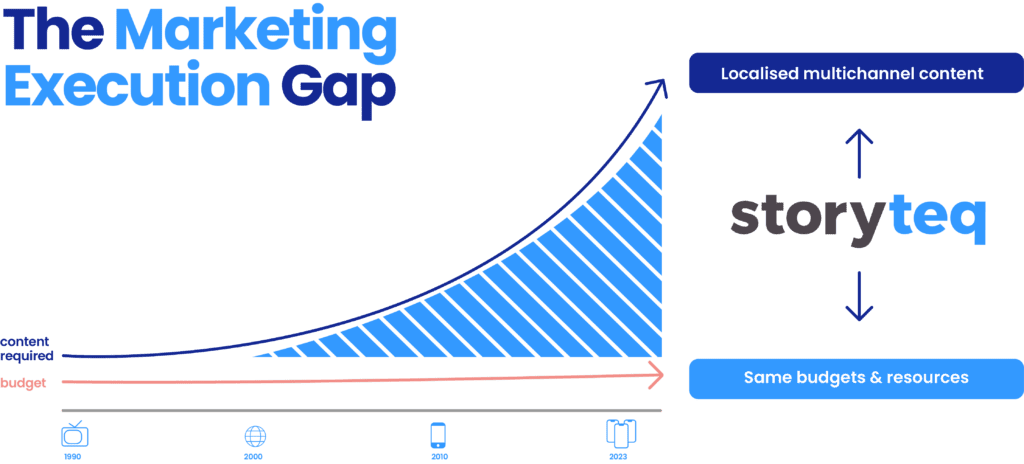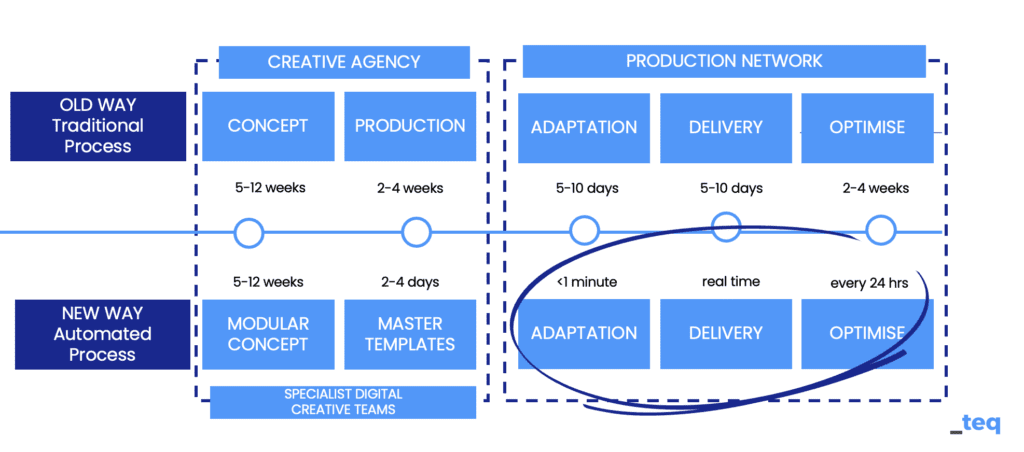Gone are the days of Mad Men “eureka” moments based on one line of impactful copy or one striking visual, distributed to a limited number of channels (think broadcast television and billboards). One size no longer fits all in a digital age which moves at an incredible pace. As this McKinsey report shows, companies who invest in their personalisation efforts generate faster rates of revenue growth. This puts a lot of pressure on the digital creative designers who cannot keep up with that level of demand. The Marketing Execution Gap is illustrated below – it shows how budgets and resources are not growing according to the content demands.

- The Marketing Execution Gap occurs when the demand for personalised and relevant content increases while budgets and resources stay the same.
- Causes include new ad channels and formats, complex global marketing workflows and ad fatigue.
- Designers and creative teams face immense pressure to deliver high volumes of content while avoiding over-straining their resources.
What causes the marketing execution gap?
The increasing number of new ad channels and formats
The rise of platforms like TikTok, YouTube and Instagram has created new content format requirements for marketers. Adapting to these formats involves not just creativity but also resources to develop and maintain consistent brand messaging on every channel.
Complex global marketing workflows
As brands expand globally, marketing workflows become more challenging due to increased distances and cultural differences having an impact on collaboration. Technology can facilitate the localisation and personalisation of content, even across these dispersed workforces. By introducing Creative Automation into your workflows, you can gain huge efficiencies by centralising content production, delivery and optimisation.

Ad fatigue
The lack of personalised and localised content can lead to ad fatigue which is when consumers become disinterested and unresponsive to advertisements. This not only affects potential customers but can negatively impact ad platform performance. In fact, a report by Simulmedia states that users who were over saturated with the same ad (saw the ad 6-10 times) were 4.1% less likely to buy a product.
Constantly testing content and rotating ad creatives based on the results is one resolution to this, as VooDoo did with Storyteq. But what are other advertising agencies and marketing teams doing now to prevent the gap deepening?
Strategies for closing the Execution Gap
Brands are employing diverse methods to address the Marketing Execution Gap. For example, outsourcing, increasing headcount or relying heavily on creative teams. However, many of these strategies are short-term solutions that may not prove sustainable.
Embracing Creative Automation
Creative Automation offers a revolutionary approach to bridging the Marketing Execution Gap. By automating creative asset production, this technology enables rapid adaptation and modification of content across various formats and channels.
The importance of integration
Integrating Creative Automation into marketing workflows maximises efficiency and drives value. Connecting every aspect of the creative process from ideation through to ad optimisation enables seamless collaboration across teams.
Success stories and innovations
Brands and creative agencies like Boomerang have leveraged Creative Automation to produce more variations of content with reduced time, effort and cost. The adoption of this technology has allowed these companies to optimise their advertising efforts and boost performance.
“We use Storyteq a lot to optimise our digital creative assets, but also to make our concept smarter, scalable, and more flexible. We needed a smarter way to create more content.”
Bo The, CEO of Boomerang, part of Publicis Groupe
By combining talent and technology, Boomerang can make more variations of their content, and they do this for less time, less money, and less repetitive work.
Creative Automation and ad optimisation
With Creative Automation, many video ad versions are rendered in bulk at an accelerated rate. By pushing these versions directly to publishing platforms, ad channels, and Digital Asset Management platforms (DAMs), best-performing creative assets can be quickly identified.
Therefore, an execution benefit that Creative Automation also enables is that of Dynamic Creative Optimization (DCO). Real-time decisions can be made about what ad creative to serve based on analysis of a significant number of variations.
Key takeaways
- Conventional solutions to closing the Marketing Execution Gap are unsustainable and may lead to increased costs.
- Creative Automation provides a long-term, transformative solution to scaling creative asset production and addressing the growing content demands.
Wrapping up
Creative Automation can help alleviate petty manual work and return time for real creativity. Marketers, when armed with a new resource for scaling their content, are less dependent on designers for the variations they need. They now also have more time to focus on high level strategic activities to increase revenue.
With marketing and creative teams both reaching their targets, in a timely and cost-effective manner, Creative Automation can fill the marketing execution gap and truly create sustainable transformation.